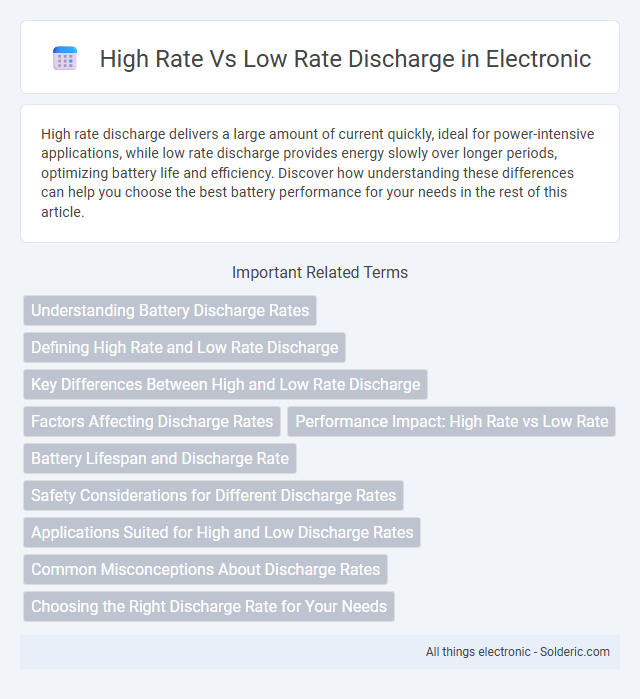High rate discharge delivers a large amount of current quickly, ideal for power-intensive applications, while low rate discharge provides energy slowly over longer periods, optimizing battery life and efficiency. Discover how understanding these differences can help you choose the best battery performance for your needs in the rest of this article.
Comparison Table
| Feature | High Rate Discharge | Low Rate Discharge |
|---|---|---|
| Discharge Current | High (typically above 1C) | Low (typically below 0.5C) |
| Battery Capacity Utilization | Lower due to high current stress | Higher, more efficient capacity use |
| Battery Life Cycle | Shorter cycle life | Longer cycle life |
| Heat Generation | High heat buildup | Minimal heat generation |
| Application | Power tools, electric vehicles requiring bursts of power | Backup power, low-power devices, energy storage systems |
| Voltage Stability | More voltage drop during discharge | More stable voltage output |
Understanding Battery Discharge Rates
Battery discharge rates describe how quickly a battery releases its stored energy, measured in C-rates, where a high rate discharge (e.g., 2C) means the battery empties in half an hour, and a low rate discharge (e.g., 0.5C) extends usage to two hours or more. High rate discharge increases internal resistance and heat generation, potentially reducing battery lifespan and capacity, whereas low rate discharge preserves battery health and efficiency by minimizing thermal stress. Recognizing these differences is essential for optimizing battery performance in applications like electric vehicles, power tools, and energy storage systems.
Defining High Rate and Low Rate Discharge
High rate discharge refers to the rapid release of electrical energy from a battery, typically measured in terms of the C-rate, where a high rate indicates discharging the battery at or above its nominal capacity within an hour or less. Low rate discharge involves a slower, more controlled release of energy, often extending the battery life due to reduced stress on the cells and lower heat generation. Understanding these rates helps you optimize battery performance for applications requiring either quick bursts of power or prolonged, steady energy output.
Key Differences Between High and Low Rate Discharge
High rate discharge involves releasing a battery's stored energy rapidly, resulting in higher current output and shorter run time, while low rate discharge delivers energy more slowly with lower current and extended duration. The key differences include heat generation, where high rate discharge produces more heat affecting battery life, and efficiency, as low rate discharge maintains better energy retention and longer overall battery performance. Your choice between high and low rate discharge depends on power needs, thermal management, and required operational time.
Factors Affecting Discharge Rates
Discharge rates in batteries are influenced by temperature, battery chemistry, and internal resistance, with high rates generating more heat and accelerating degradation. The electrode surface area and electrolyte composition determine ion flow efficiency, directly impacting whether a battery supports a high or low rate discharge. Manufacturers optimize these factors to balance energy output and lifespan, crucial for applications requiring rapid power delivery or extended use.
Performance Impact: High Rate vs Low Rate
High rate discharge significantly affects battery performance by increasing internal resistance and heat generation, which can reduce overall capacity and lifespan. Low rate discharge optimizes energy efficiency and promotes longer cycle life by maintaining stable electrode reactions and minimizing stress on battery materials. Understanding the discharge rate impact helps you balance power output and durability for optimal battery utilization.
Battery Lifespan and Discharge Rate
High rate discharge significantly shortens battery lifespan due to increased heat generation and accelerated chemical degradation within the cells. Low rate discharge preserves battery health by maintaining stable internal temperatures and reducing stress on the electrode materials, thus extending your battery's overall durability. Understanding the impact of discharge rate on battery performance ensures optimized usage and longer service life.
Safety Considerations for Different Discharge Rates
High rate discharge batteries generate more heat and stress on internal components, increasing the risk of thermal runaway and potential safety hazards. Low rate discharge reduces these risks by maintaining lower operating temperatures and minimizing internal strain, enhancing overall battery longevity and safety. Understanding your battery's discharge rate helps prevent accidents and ensures safe, efficient performance under varying load conditions.
Applications Suited for High and Low Discharge Rates
High-rate discharge batteries are ideal for applications requiring rapid bursts of power, such as power tools, electric vehicles, and emergency backup systems, where quick energy delivery is critical. Low-rate discharge batteries excel in scenarios needing prolonged, steady energy output, like remote sensors, medical devices, and renewable energy storage, ensuring reliable performance over extended periods. Selecting the right discharge rate depends on your device's power demands and usage duration for optimal efficiency and battery lifespan.
Common Misconceptions About Discharge Rates
Many believe that a low discharge rate always means longer battery life, but high-rate discharge batteries can deliver significant power without drastically reducing lifespan when designed for such use. Common misconceptions ignore that discharge rate impacts not only capacity but also battery temperature and internal resistance, which are critical for performance and safety. Understanding the true effects of high versus low rate discharge helps you choose the right battery for specific power demands.
Choosing the Right Discharge Rate for Your Needs
Selecting the appropriate discharge rate depends on balancing energy requirements and battery longevity. High-rate discharge batteries deliver rapid power output, ideal for devices needing quick bursts of energy, but can reduce overall battery life. Low-rate discharge batteries provide a steady, prolonged current suitable for devices with consistent power consumption, optimizing efficiency and extending operational time.
High rate vs Low rate discharge Infographic

 solderic.com
solderic.com